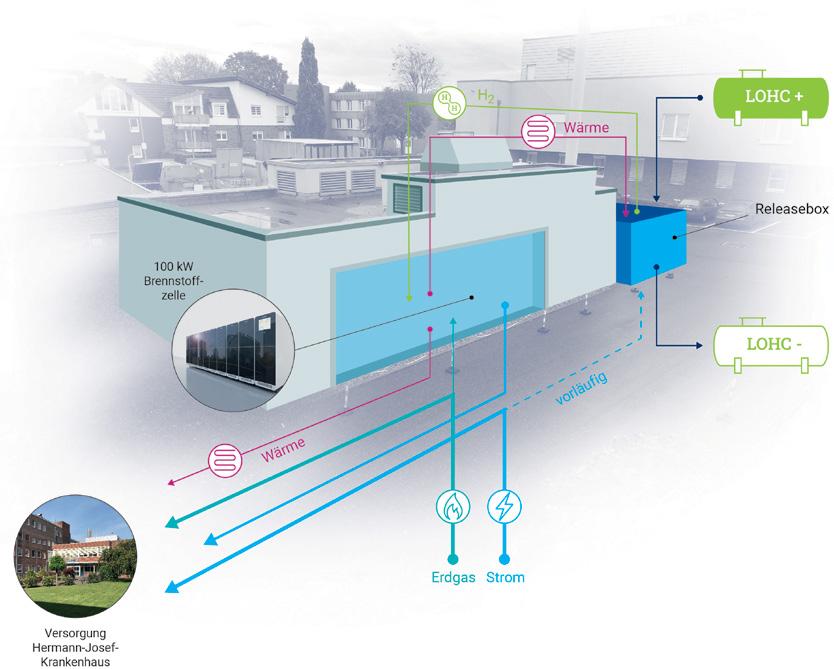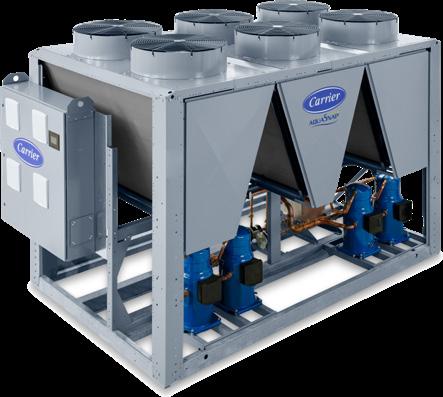
6 minute read
Germany Electricity & Heat For Erkelenz
Hospital
Hermann Josef Hospital (HJK) in Erkelenz is hosting a showcase project for the climate-friendly energy supply of the future. Robert Bosch GmbH and Hydrogenious LOHC NRW GmbH are working at HJK to demonstrate the coupling of new hydrogen technologies on an economically relevant scale for the first time. This project is designed to drive forward the energy transition. It is one of several major research projects in the Rhenish mining area in western Germany expected to help make a success of structural change. The Helmholtz Hydrogen Cluster (HCH2), based at Forschungszentrum Jülich, is coordinating this demonstration project.
Called Multi-SOFC, the project aims to deliver a significant reduction in carbon emissions and a more efficient energy supply for HJK. The partners are looking to demonstrate the innovative combination of two novel hydrogen technologies by the end of 2026, with a view to evaluating a more climate-friendly and ultimately less expensive solution. They will examine whether the Multi-SOFC project can meet half the hospital’s base load. The demonstration project is intended to be a globally visible model for the future energy supply of large buildings, and is being funded by Germany’s Federal Ministry of Education and Research to the tune of 23.6 million euros.
Sofc System Supplies Hospital With Electricity And Heat
The Multi-SOFC project focuses on the solid oxide fuel cell (SOFC) system developed by Robert Bosch GmbH for supplying electricity and heat. In a subsequent expansion stage starting in early 2025, Hydrogenious LOHC NRW GmbH, a subsidiary of Hydrogenious LOHC Technologies in Erlangen, will supply the project with hydrogen by means of liquid organic hydrogen carrier (LOHC) technology. A pilot installation consisting of ten fuel-cell units with a performance range of 100 kilowatt will supplement the existing combined heat and power plant at the hospital in Erkelenz. It is the first pilot system of this scale to be installed by Bosch for regular operation. The system is scheduled to be commissioned in mid-2023. The hospital’s full supply of energy is secure even without the new installations.
Cutting Carbon Emissions
By 40 Percent
In the first phase of the project, the SOFC system will run on natural gas. This already offers advantages in comparison with HJK’s existing gas engine, which also runs on natural gas: the SOFC system achieves 60 percent electrical efficiency, while the gas engine achieves about 36 percent. As a result, SOFC systems emit almost 40 percent less CO2 than gas engines when generating electricity from pure natural gas. Because it will be in continuous operation at the hospital, this means that even in its first stage, the project will already reduce carbon emissions by 150 metric tons per year. The heat generated when the natural gas is converted into electricity in the SOFC system will initially be used to heat the hospital. With this combination of electricity and heat, an SOFC system achieves an overall high level of efficiency at the beginning of its life cycle – around 85 percent. As the project proceeds, the partners plan to gradually increase the proportion of hydrogen in the gas mixture for the SOFC system – and thus achieve further reductions in carbon emissions.
Hydrogen From A Carrier Liquid For The Sofc System
Starting in 2025, the SOFC system will be supplied with hydrogen that has been chemically bonded to a liquid organic hydrogen carrier (LOHC): the hydrogen stored in the LOHC will be released in a dehydrogenation unit, to be installed on-site by Hydrogenious, and then fed into the fuel cell. This LOHC system will be ramped up using heat from the SOFC system, which in the future will also provide the energy needed for the reaction to release the hydrogen from the LOHC. Until then, the system will be heated electrically.
The project in Erkelenz is the first of several demonstrators that the HC-H2 is coordinating in the Rhenish mining area. This Helmholtz cluster comprises the Institute for Sustainable Hydrogen Economy (INW), which was founded in 2021 at Forschungszentrum Jülich, and its project partners from industry, business, research, and the local authorities. The HC-H2 wants to use the Rhenish mining area to demonstrate novel climate-friendly hydrogen storage technologies that can be applied worldwide. Its second main goal is to create new jobs and inject new strength into the mining area’s economy to compensate for the phaseout of lignite, which will take place by 2030.
Additional Information: The Advantages Of Hydrogenious LOHC Technology
The LOHC technology that Hydrogenious LOHC NRW is installing in Erkelenz is an innovative solution for the particularly safe storage and efficient transportation of hydrogen. Hydrogenious’s specific LOHC technology bonds hydrogen to benzyl toluene – a thermal oil that can be easily and safely handled at ambient pressure and temperature. Even when loaded with hydrogen, this LOHC will not readily ignite and is nonexplosive, making it ideal for use at HJK, among other applications. Furthermore, there is no “boil-off” from the LOHC, meaning it loses no hydrogen over time. Alternative methods – such as high-pressure compression or liquefying the hydrogen by cooling it to minus 253 degrees Celsius – are comparatively energy-intensive and require more effort to prevent hydrogen loss and ensure system safety.
What The Project Partners Say:
Jann Habbinga, Administrative Director of Hermann Josef Hospital Erkelenz
“Our hospital’s clinical operations consistently consume at least 92 kilowatts of electricity and 220 kilowatts of heat per year. Because we operate around the clock, we have a constant level of demand, which was a key point for the project. We feel it’s important to help develop hydrogen technologies, and we’re very pleased to be a part of this innovation project.”
Dr. Wilfried Kölscheid, Senior Vice President At Bosch And Responsible For The Stationary Solid-Oxide Fuel-Cell Program:
“Having a decentralized power supply is becoming increasingly essential. Our solid oxide fuel cell system generates electricity in a climate-friendly and demand-driven manner. This is our way of securing the supply for critical infrastructure such as hospitals and playing an important part in climate action. The project in Erkelenz is a great opportunity to use our SOFC system in the infrastructure of a hospital for the first time, and will later demonstrate the benefits of using the system in combination with an LOHC system.”

“Multi-SOFC is our first demonstration project. We’re proud that we’ve managed to get this far just 15 months after our founding. We’re growing not only at our headquarters in the Brainergy Park in Jülich, but also with our demonstration projects in the Rhenish mining area. The project is an important milestone because, together with our partners, we’re demonstrating for the first time on a large scale a technology that can be a global solution for climate-friendly energy supply to large building complexes.”
Dr. Caspar Paetz, Chief Technology Officer at Hydrogenious LOHC Technologies:

“As a pioneer in the field of liquid organic hydrogen carriers, it’s crucial for us to demonstrate the potential synergy effects in practice. The project in Erkelenz is impressive proof of the huge potential that lies in combining innovative hydrogen technologies. At the same time, it’s a wonderful opportunity for us to demonstrate climatefriendly energy supply in North Rhine-Westphalia. We’ve shown our willingness to make a sustainable commitment to the region not least through the establishment of our subsidiary Hydrogenious LOHC NRW GmbH.”

Carrier
New AquaSnap 30RC Air Cooled Chiller
Carrier introduced the all-new AquaSnap® 30RC air-cooled scroll chiller featuring Greenspeed® intelligence and R-32 refrigerant, which complies with Jan. 1, 2024 low global warming potential (GWP) requirements, with best in class energy-efficiency while delivering quieter operation within a tiered design for a broader operating range and design flexibility*. Carrier is a part of Carrier Global Corporation (NYSE: CARR).

The AquaSnap 30RC was developed with advanced features to ensure performance and efficiency with a new compact tier unit design, providing customers with the option to choose the chiller that fits their business and sustainability needs. The optimizations boost the integrated part load values (IPLV) up to 18 for a wide range of applications from 60 to 150 tons using GWP R-32 refrigerant to further reduce impact on the environment. The chiller’s new compact tier design, with a physical footprint less than standard chillers, enables it to be deployed where space is tight without compromising performance. With the high cost of real estate, Carrier developed the smaller footprint chiller for a range of applications where optimum space utilization is crucial.
The AquaSnap 30RC with Greenspeed intelligence is ideally suited for office buildings, schools, data centers, hotels, hospitals and any other applications where quieter operation, high efficiency and a flexible footprint are requirements. This new model features variable frequency drives for the fan motors along with advanced PIC6 controls to obtain optimal chiller performance.
Company: Carrier
More Information: www.carrier.com/30RC
*As compared to published efficiencies.










